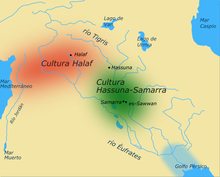Hassuna culture
 |
|
| Geographical range | Mesopotamia |
|---|---|
| Period | Neolithic |
| Dates | circa 6000 BC |
| Type site | Tell Hassuna |
| Major sites | Tell Shemshara |
| Preceded by | Pre-Pottery Neolithic B, Halaf culture |
| Followed by | Ubaid period |
The Hassuna culture is a Neolithic archaeological culture in northern Mesopotamia dating to the early sixth millennium BC. It is named after the type site of Tell Hassuna in Iraq. Other sites where Hassuna material has been found include Tell Shemshara.
By around 6000 BC people had moved into the foothills (piedmont) of northernmost Mesopotamia where there was enough rainfall to allow for "dry" agriculture in some places. These were the first farmers in northernmost Mesopotamia. They made Hassuna-style pottery (cream slip with reddish paint in linear designs). Hassuna people lived in small villages or hamlets ranging from 2 to 8 acres (3.2 ha).
At Tell Hassuna, adobe dwellings built around open central courts with fine painted pottery replace earlier levels with crude pottery. Hand axes, sickles, grinding stones, bins, baking ovens and numerous bones of domesticated animals reflect settled agricultural life. Female figurines have been related to worship and jar burials within which food was placed related to belief in afterlife. The relationship of Hassuna pottery to that of Jericho suggests that village culture was becoming widespread.
...
Wikipedia
